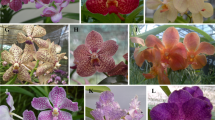Summary
With barley a large variation in frequency of plant formation from microspores of spikes from the same plant has been observed. The highest frequency of plant formation was obtained when culturing anthers in the dark on a high Ficoll medium containing 2,4-D and kinetin to induce proembryo (or callus) formation. Subsequently the proembryos or calli were cultured in dim light on a high Ficoll-high sugar medium containing IBA and kinetin. Finally the embryos were transferred to a starch agar medium. A maximum of 13 green plants were obtained from microspores of a single anther.
The ratios of green to albino microspore derived plants varied from 9∶1 to 1∶9 depending on culture conditions. Under anaerobic conditions, lactic acid and other organic acids may have damaged the organelles in the cells resulting in the formation of albino plants. Thus, direct embryogenesis by using a well-buffered, high Ficoll-high sugar medium and proper aeration are essential for obtaining high frequency of green plants from microspores.
Similar content being viewed by others
Abbreviations
- 2,4-D:
-
2,4 dichlorophenoxyacetic acid
- IBA:
-
3 indolylbutyric acid
References
Aruga K, Nakajima T (1985) Japan. J. Breed. 35: 390–397.
Bradford MM (1976) Anal. Biochem. 72: 248–254.
Davies DD, Grego S, Kenworth P (1974) Planta. 118: 297–310.
Dunwell JM (1985) Anther and ovary culture, in: “Cereal Tissue and Cell Culture,” S.W.J. Bright and M.G.K. Jones, ed., Martinus Nijhoff/Dr. W. Junk Publishers, pp 1–44.
Foroughi-Wehr B, Mix G, Gual H, Wilson HM (1976) Z. Pflanzenzuchtg. 77: 198–204.
Ghandimathi H (1982) Direct pollen cultured of Nicotiana tabacum. in: “Plant Tissue Cultures 1982,” A. Fujuwara, ed., The Japanese Association for Plant Tissue Culture, Tokyo, pp 527–528.
Hanson AD, Jacobsen JA (1984) Plant Physiol. 75: 566–572.
Huang B, Sunderland N (1982) Ann. Bot. 49: 77–87.
Kao KN (1981) Z. Pflanzenphysiol. 103: 437–443.
Kao KN, Horn DC (1984) Induction of pollen plant formation in barley anther culture, in: “International Symposium on Genetic Manipulation in Crops,” Oct. 22–25, Beijing, China (in press).
Linskens HF, Jackson JF eds. (1986) Springer-Verlag, Berlin.
Sorvari S, Schieder O (1987) Plant Breeding 99: 164–171.
Sunderland NM, Roberts M, Evans LJ, Wildon DC (1979) J.Exptl. Bot. 30: 1133–1144.
Wei ZM, Kyo M, Harada H (1986) Theor. Appl. Genet. 72: 252–255.
Xu ZH, Sunderland N (1981) Plant Sci. Lett. 23: 161–168.
Ye JM, Harvey BS, Kao KN (1985) Can. J. Plant Sci. 65: 29–32.
Author information
Authors and Affiliations
Additional information
Communicated by F. Constabel
Rights and permissions
About this article
Cite this article
Kao, K.N., Saleem, M., Abrams, S. et al. Culture conditions for induction of green plants from barley microspores by anther culture methods. Plant Cell Reports 9, 595–601 (1991). https://doi.org/10.1007/BF00231796
Received:
Revised:
Issue Date:
DOI: https://doi.org/10.1007/BF00231796




